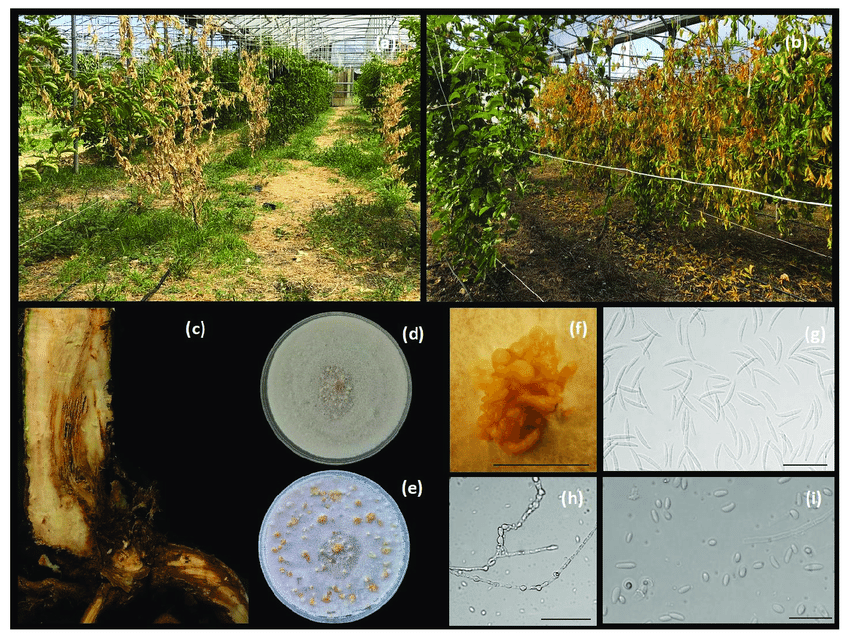Fusarium wilt in dragon fruit represents a vexing challenge for enthusiasts and commercial growers alike, casting a shadow over the health and productivity of these captivating succulents. Fusarium wilt, which is characterised by the sneaky invasion of fungal pathogens, takes a toll on the root system and compromises nutrient uptake and water absorption, which ultimately results in plant death.
Table of Contents
Fusarium Wilt in Dragon Fruit: Causes, Symptoms, and Remedies

Demystifying the Origins: Understanding Fusarium Wilt in Dragon Fruit
The genesis of fusarium wilt in dragon fruit can be traced to the infiltration of soilborne fungal pathogens, notably Fusarium oxysporum f. sp. lycopersici. These stealthy invaders exploit vulnerabilities within the plant’s defense mechanisms, gaining ingress through wounds and natural openings, and establishing a stronghold within the vascular system.
Fusarium wilt thrives in environments characterized by warm temperatures and moisture-laden soils, perpetuating its life cycle and disseminating spores with alarming efficiency. Soil compaction and poor drainage exacerbate the risk of infection, creating an environment conducive to fungal proliferation and disease dissemination.

Deciphering the Telltale Signs: Recognizing Fusarium Wilt in Dragon Fruit
Identification of fusarium wilt in dragon fruit hinges upon astute observation and discernment. Early detection is paramount to implementing effective intervention strategies and curbing the spread of infection throughout the orchard.
Symptoms of fusarium wilt manifest gradually, initially presenting as wilting and yellowing of foliage. As the fungal pathogens colonize the vascular tissues, vascular discoloration becomes evident, imparting a characteristic reddish-brown hue upon the affected vascular bundles.
Root necrosis and decay ensue, compromising the structural integrity of the root system and impeding the plant’s ability to absorb water and nutrients. Foliage becomes stunted and chlorotic, reflecting the underlying vascular dysfunction and nutrient deficiency perpetuated by fusarium wilt.

Navigating the Path to Recovery: Managing Fusarium Wilt in Dragon Fruit
Combatting fusarium wilt in dragon fruit demands a multifaceted approach, encompassing preventive measures and targeted interventions aimed at fortifying the plant’s natural defenses and mitigating the spread of infection.
1. Embrace Cultural Practices
Institute cultural practices designed to mitigate the risk of fusarium wilt. Practice crop rotation to disrupt the life cycle of fungal pathogens and reduce the buildup of inoculum within the soil. Utilize cover crops and organic mulches to enhance soil structure and promote microbial diversity.
2. Enhance Soil Health
Optimize soil health to fortify the plant’s natural defenses against fusarium wilt. Amend soil with organic matter to improve drainage and enhance nutrient retention. Incorporate beneficial microorganisms such as mycorrhizae to stimulate root development and bolster plant resilience.
3. Implement Biocontrol Agents
Introduce biocontrol agents to suppress the proliferation of fusarium wilt. Utilize beneficial fungi such as Trichoderma spp. to antagonize fungal pathogens and inhibit their growth. Apply biofungicides containing Bacillus spp. to confer systemic protection against fusarium wilt and enhance plant vigor.
4. Practice Vigilance
Maintain vigilance in monitoring the orchard for signs of fusarium wilt. Conduct regular inspections of plants, scrutinizing for symptoms of wilting, vascular discoloration, and root necrosis. Implement timely intervention measures to mitigate the spread of infection and preserve the health of the orchard.
5. Opt for Resistant Varieties
Select dragon fruit varieties renowned for their resistance to fusarium wilt. Prioritize cultivars bred for genetic resilience against fungal pathogens, minimizing the risk of infection and enhancing the long-term viability of the orchard.
6. Optimize Irrigation Practices
Exercise prudence in irrigation practices to mitigate the risk of fusarium wilt. Implement drip irrigation systems to deliver water directly to the root zone, minimizing foliage wetness and reducing the likelihood of fungal proliferation. Avoid overwatering and ensure adequate soil drainage to prevent waterlogging.
Conclusion
In conclusion, fusarium wilt in dragon fruit poses a formidable challenge to growers, necessitating proactive measures and diligent oversight to mitigate its deleterious effects. By fostering a culture of vigilance and embracing innovative approaches to disease management, enthusiasts can cultivate thriving ecosystems teeming with the resplendent beauty of dragon fruit. Let us embark on a journey of resilience and stewardship, nurturing our dragon fruit plants to unparalleled heights of vitality and splendour.
